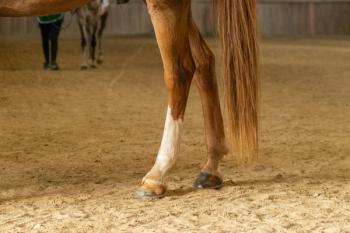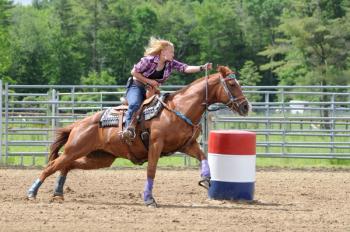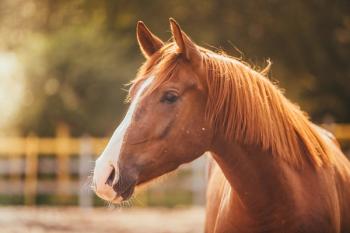
Pituitary dysfunction in the older horse (Proceedings)
Pituitary Pars Intermedia Dysfunction, PPID, also known as equine pituitary adenoma, equine Cushings, and equine pituitary hyperplasia is the most common endocrinologic problem in horses.
Pituitary Pars Intermedia Dysfunction, PPID, also known as equine pituitary adenoma, equine Cushings, and equine pituitary hyperplasia is the most common endocrinologic problem in horses. The pituitary gland is an embryonic extension of nervous tissue from the brain (neurohypophysis) and epithelia from the oral cavity (adenohypophysis).
The adenohypophysis is composed of the pars distalis (PD), pars tuberalis (PT) and pars intermedia (PI). Pars intermedia is controlled by melanotropes that possess Dopamine (D2) receptors and respond to tonic inhibition of dopminergic neurons that originate in the hypothalamus. Horses differ from other species such as the dog, cat ad human in that pituitary adenomas occur in the pars intermedia lobe rather than the par distalis region.
The precursor protein, PRO-OPIO-MELANO-CORTIN (POMC), is cleaved to produce MSH,
Melanocyte stimulating hormone], ACTH [Adrenocorticotropin hormone],LPH [lipotropin],CLIP [corticotropin – like intermediate lobe peptide] and β endorphin. The pathogenesis of PPID involves a dopaminergic neurodegenerative disease that is supported by the fact that dopamine-containing neurons are particularly sensitive to oxidative stress. Markers of oxidative stress are increased in the hypothalamus of horses with PPID. Without the inhibitory effect of dopamine, melanotropes hypertrophy and eventually undergo neoplastic change into adenomas.
PPID is a disease of the older horse – youngest diagnosed was 7 years of age but this is rare. Most affected horses are > 18 years of age and the disease becomes more prevalent as the horses age. It occurs in all breeds and there is antidotal evidence to suggest that there is a higher prevalence in ponies and Morgans.
Hirsutism is the most common sign of PPID. If present it should be considered a positive diagnosis. It is not always the first sign of PPID. In fact the extremely hairy horse that is classic for PPID is probably a late stage case. One needs to assess hair coat abnormalities in summer in New England because some horses, particularly ponies may not shed out until May or June. In comparing a study that looked at hospitalized cases, it appeared that there was an 11% incidence of the disease with about 18% of these cases being diagnosed at post mortem not clinically. In comparison, a survey study that asked the incidence of PPID in a population of non-hospitalized older horses– 9% said that their horses had been diagnosed with PPID by their veterinarian while 25% of that population did not have hirsutism.
Another 18% of owners said that their horses didn't shed out in summer but were not diagnosed as PPID. Therefore the incidence in New England may be between 9-27%, McGowan, Hodgson found that PPID had 14% prevalence in Queensland, Australia, based on increases in ACTH and MSH. 12% of these cases did not show clinical signs of hirsutism.
Other clinical signs that have been reported in the PPID horse include poor muscle tone and pendulous abdomens. An abnormal distribution of adipose tissue is sometimes seen over the tail head and crest of the neck. Bilateral non-painful swelling in peri-orbital region has also been connected with PPID. Affected horses have an increased susceptibility to infections and decreased healing. Hoof abscesses, sinusitis and tooth root abscesses are common site of infection. Old horses with PPID were more likely to develop laminitis.
Clinicopathologic abnormalities in the PPID horse besides the hormone levels include hyperglycemia - reported in 26 - 85% of horses with pituitary dysfunction, elevations in serum alkaline phosphatase, and less commonly - neutrophilia with a lymphopenia.
Diagnostic testing for PPID has been studied for decades and we have still not found the single most reliable test. ACTH levels were first looked at in the late 1980's. Normal values were established but later found to have a seasonal variation. MSH is also a test used mostly for research purposes to help in the diagnosis. It also has a seasonal variation. Previous recommendations included not testing during the months of August, September and October because of the fear that we would get false positive diagnosis in normal horses due to the seasonal rise. More recently it is being suggested that this is a good time to test because even though there is a seasonal rise at during those months in normal horses, the season affects the abnormal horse to a greater extent and may make it easier to pick up the affected horses.
Other diagnostic testing have included challenge tests such as the dexamethasone suppression test, the TRH stimulation test and the domperidone stimulation test. All of these have some merit in the development of a diagnosis.
Finally insulin levels have been found to be elevated in a certain number of PPID horses. It appears that some PPID horses are insulin resistance similar to those horses with metabolic syndrome. Antidotal data suggests that metabolic syndrome in a younger horse is a risk factor for the development of PPID as the horse ages. It is of interest to correlate the incidence of laminitis seen in the PPID horse with insulin levels as well. Perhaps it is the insulin resistance and not the actual PPID that increases the risk for laminitis.
As seen above there is sometimes a discrepancy between clinical signs and elevated hormone levels. This discrepancy in a subset of horses suggests that hormonal imbalances may precede the clinical signs. It is important to find a way to identify the early cases if we are to intervene at a stage where we can decrease the progress of the dysfunction.
Currently our treatment of this disease consists of good management. Full body clip in summer if they don't shed out, is important in keeping the animal comfortable. Any infections or injuries should be treated aggressively because of the decreased healing in affected horses. Some PPID horses are PUPD so adequate water availability is important. Because some of the PPID horses are insulin resistant, a low carbohydrate diet may be helpful in preventing laminitis.
It is important to keep the nonstructural carbohydrates found in grass, hay and grain to less than 11%. This can be difficult if you don't have your hay analyzed. Some hays in New England have a NSC up to 19%. PPID horses with a high body condition score should be tested for insulin levels. One should restrict their calorie intake by eliminating grain from the diet and decreasing the hay intake to 1.5% of their body weight. If the PPID horse has a thin body condition and an elevated insulin level, you can consider the “safe” starch alternatives for grains.
Besides management, drug therapy for PPID is available. The drugs most commonly used include pergolide, cyproheptadine, trilostane and casteberry. Pergolide is dopaminergic agonist – increasing dopaminergic tone in pars intermedia at the level of melanotropes cell thus down regulates secretory function. Controlled studies show ACTH decrease and hirsutism may improve. The dose of pergolide is 0.5 mg/horse, orally for 6-8 weeks. If no response is seen then the dose can be increased in increments of .25 - .5 mg/day (up to 3 mg/day). Adverse effects of pergolide include depression, anorexia and ataxia.
Cyproheptadine was one of the first drugs used to treat PPID in horses. There was mixed results but some feel that it is synergistic with pergolide. The dose is 0.25 mg/kg/day, orally for 6-8 weeks and increased to 0.5 mg/kg/day divided is there is no response. Trilostane is used in dogs with Cushing's syndrome and acts to block steroidogensis.
One study reported that it may improve clinical signs of lethargy, PUPD and laminitis in some affected animals. More work needs to be done to prove efficacy of this drug. Casteberry is an herbal therapy for PPID that is popular among horse owners. It is reported to affects dopamine levels in a manner similar to pergolide. The recommended dose is 2 oz/day. Owners will swear by the benefits but in a comparison study there was no beneficial effect on horses with PPID compared to a group treated with pergolide.
We are continuing to learn more about the pathophysiology of this dysfunction. The hope is that we can begin to recognize the disease in the early stages because by the time the horse shows clinical signs much of the damage in the pituitary is done. Once diagnosis is clearer then the treatment of the early disease is vital.
Newsletter
From exam room tips to practice management insights, get trusted veterinary news delivered straight to your inbox—subscribe to dvm360.




